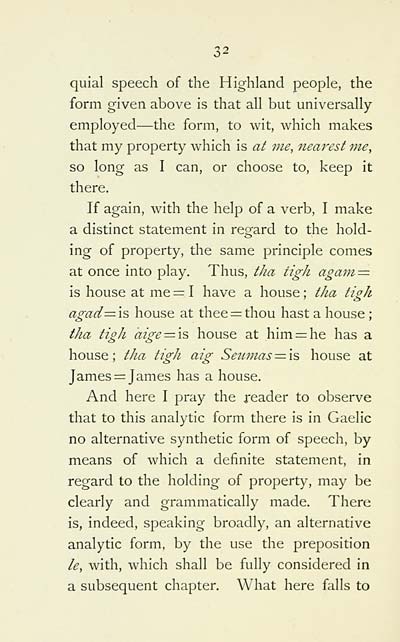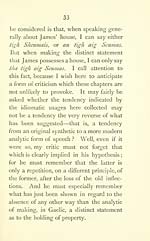Blair Collection > Vestigia celtica
(36)
Download files
Complete book:
Individual page:
Thumbnail gallery: Grid view | List view

32
quial speech of the Highland people, the
form given above is that all but universally-
employed — the form, to wit, which makes
that my property which is at me, nearest me,
so long as I can, or choose to, keep it
there.
If again, with the help of a verb, I make
a distinct statement in regard to the hold-
ing of property, the same principle comes
at once into play. Thus, tha tigh aoain =
is house at me = I have a house ; tka tigh
agad= is house at thee = thou hast a house ;
tka tigh aige = '\s house at him = he has a
house ; t/ia tigh aig Seuinas = is house at
James = James has a house.
And here I pray the reader to observe
that to this analytic form there is in Gaelic
no alternative synthetic form of speech, by-
means of which a definite statement, in
regard to the holding of property, may be
clearly and grammatically made. There
is, indeed, speaking broadly, an alternative
analytic form, by the use the preposition
/e, with, which shall be fully considered in
a subsequent chapter. What here falls to
quial speech of the Highland people, the
form given above is that all but universally-
employed — the form, to wit, which makes
that my property which is at me, nearest me,
so long as I can, or choose to, keep it
there.
If again, with the help of a verb, I make
a distinct statement in regard to the hold-
ing of property, the same principle comes
at once into play. Thus, tha tigh aoain =
is house at me = I have a house ; tka tigh
agad= is house at thee = thou hast a house ;
tka tigh aige = '\s house at him = he has a
house ; t/ia tigh aig Seuinas = is house at
James = James has a house.
And here I pray the reader to observe
that to this analytic form there is in Gaelic
no alternative synthetic form of speech, by-
means of which a definite statement, in
regard to the holding of property, may be
clearly and grammatically made. There
is, indeed, speaking broadly, an alternative
analytic form, by the use the preposition
/e, with, which shall be fully considered in
a subsequent chapter. What here falls to
Set display mode to: Large image | Transcription
Images and transcriptions on this page, including medium image downloads, may be used under the Creative Commons Attribution 4.0 International Licence unless otherwise stated. ![]()
| Early Gaelic Book Collections > Blair Collection > Vestigia celtica > (36) |
|---|
| Permanent URL | https://digital.nls.uk/75800811 |
|---|
| Description | Celtic footprints in philology ethics and religion. |
|---|---|
| Shelfmark | Blair.1 |
| Additional NLS resources: | |
| Attribution and copyright: |
|
| Description | A selection of books from a collection of more than 500 titles, mostly on religious and literary topics. Also includes some material dealing with other Celtic languages and societies. Collection created towards the end of the 19th century by Lady Evelyn Stewart Murray. |
|---|
| Description | Selected items from five 'Special and Named Printed Collections'. Includes books in Gaelic and other Celtic languages, works about the Gaels, their languages, literature, culture and history. |
|---|

